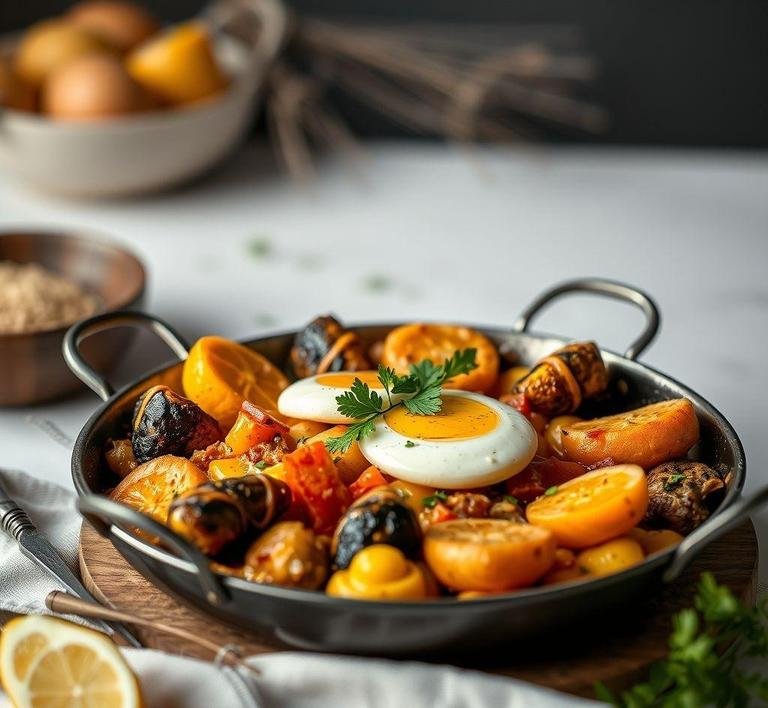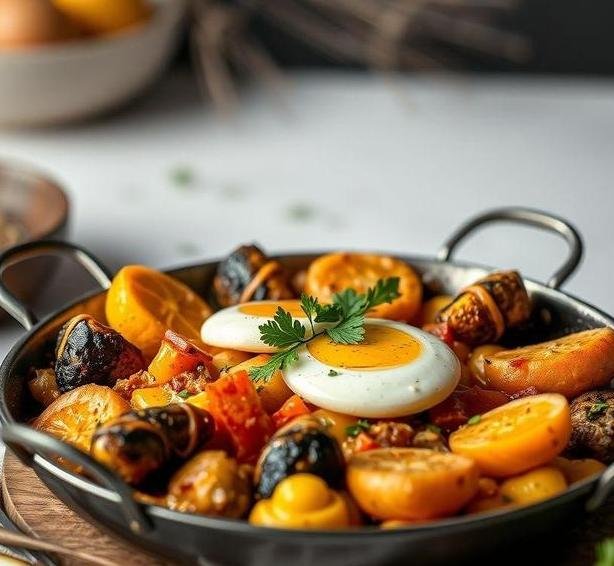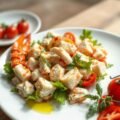Mary Berry, beloved British cook and television personality, is famous for making complex dishes accessible with her straightforward, yet flavorful approach to cooking. While her fame largely rests on her classic British recipes, her take on paella-a renowned Spanish dish-is a testament to her ability to adapt international recipes to suit a broader audience without compromising on flavor.
Paella, traditionally from Valencia in Spain, is a beloved rice-based dish that often includes seafood, chicken, and sometimes rabbit, combined with vegetables, herbs, and saffron, which gives it a beautiful golden hue. Mary Berry’s version of paella remains faithful to the original concept but streamlines the process, making it an easy, family-friendly meal that still packs the punch of Spanish culinary traditions. Her interpretation is accessible, using ingredients that are commonly found in British supermarkets, but it retains the rustic charm of the traditional Spanish dish.
Mary Berry’s Paella showcases a delightful harmony of ingredients like tender chicken, juicy prawns, and vibrant vegetables like peppers and peas. The golden color is achieved through a combination of saffron and paprika, which also infuse the dish with a rich depth of flavor. It’s a recipe that highlights the versatility of paella and invites anyone to try their hand at this iconic Spanish dish with confidence.
Mary Berry’s Paella Recipe
Ingredients Needed

Mary Berry’s Paella recipe doesn’t require any overly exotic or hard-to-find ingredients, making it both practical and approachable. Below is a list of the key ingredients:
- Chicken Thighs or Breasts (Boneless) – These provide the base of protein for the paella, contributing a succulent and tender texture. Chicken thighs are preferred for their juiciness, but breasts can work as well.
- Prawns – A must-have in most paella recipes, prawns lend a briny sweetness that balances the richness of the chicken. They are also quick to cook, making them a perfect addition to the dish.
- Chorizo (Optional) – Some versions of paella use chorizo for an added smoky, spicy flavor. In Mary Berry’s recipe, chorizo is used sparingly, giving the dish just a hint of spice and depth without overpowering the other ingredients.
- Bell Peppers (Red, Yellow, or Green) – These sweet peppers provide both color and crunch, as well as a touch of sweetness that contrasts beautifully with the savory proteins.
- Onion and Garlic – Aromatic onions and garlic are essential for developing the base flavor of the dish. These ingredients are sautéed to create a flavorful foundation that carries the entire dish.
- Tomatoes (Canned or Fresh) – Tomatoes add a slight acidity and sweetness, rounding out the flavors of the paella. In her version, Mary Berry uses chopped tomatoes to bring some moisture and richness to the dish.
- Paella Rice (or Arborio Rice) – The key to a perfect paella lies in the rice. Paella rice absorbs all the wonderful flavors while maintaining its structure. While authentic paella rice is ideal, Arborio rice (commonly used for risotto) is an acceptable substitute.
- Saffron – This is the ingredient that truly defines paella. Saffron is known for its distinct aroma and golden color, and while it can be pricey, it’s worth the investment for an authentic taste.
- Paprika – Adds a subtle smokiness and depth of flavor that complements the saffron perfectly.
- Frozen Peas – A common addition to paella, frozen peas provide pops of green and add freshness to the dish.
- Chicken Stock – This liquid is essential for cooking the rice and providing additional flavor. Chicken stock enhances the overall savory richness of the paella.
- Olive Oil – Used for sautéing the vegetables and proteins, olive oil adds both flavor and richness to the paella.
- Lemon – A squeeze of lemon juice just before serving adds a refreshing zing and brightens up the deep flavors of the dish.
Equipment Needed
To make Mary Berry’s Paella, there are a few essential pieces of equipment that will help you achieve the perfect texture and flavor. Here’s a list of what you’ll need:
- Paella Pan – The traditional vessel for making paella is the shallow, wide pan known as a paellera. While it’s not mandatory, using a paella pan ensures that the rice cooks evenly and forms a crispy layer at the bottom-something every true paella lover craves.
- Large Frying Pan or Skillet – If you don’t have a paella pan, a large frying pan or skillet will work just fine. The key is to have enough surface area to allow the rice to spread out evenly.
- Sharp Knife – A sharp knife is essential for chopping the chicken, vegetables, and other ingredients. A good chef’s knife will make the prep work easier and quicker.
- Wooden Spoon or Spatula – For stirring and turning the ingredients, a wooden spoon or spatula is ideal. It won’t damage the surface of your pan, and it helps evenly distribute the heat.
- Lid – A lid is useful for covering the paella while the rice is cooking, allowing it to steam and cook through without drying out.
- Measuring Spoons and Cups – Precision is key when it comes to spices, especially saffron, so having accurate measuring tools is helpful.
- Tongs – Tongs are useful for flipping the chicken and prawns, allowing you to cook them evenly without breaking them apart.
Instructions To Make Mary Berry’s Paella
Here’s a step-by-step guide to making Mary Berry’s paella:
- Prepare the Ingredients: Start by chopping your chicken into bite-sized pieces, slicing your bell peppers, and finely chopping your onions and garlic. If you’re using chorizo, slice it into thin rounds. Set everything aside and have it ready for use.
- Cook the Chicken: Heat a paella pan (or large frying pan) over medium heat and add a little olive oil. Season the chicken pieces with salt and pepper, then add them to the pan. Cook for about 5-6 minutes until they start to brown on all sides. Remove the chicken from the pan and set it aside.
- Sauté the Vegetables: In the same pan, add a bit more olive oil if necessary, and sauté the onion and garlic until they become fragrant and translucent, around 3 minutes. Add the bell peppers and cook for an additional 2 minutes, allowing them to soften.
- Add the Spices and Tomatoes: Stir in the paprika and saffron (which you can steep in a bit of warm stock or water for a few minutes beforehand). Add the chopped tomatoes, and cook the mixture down for 5 minutes until the tomatoes have broken down into a soft, chunky sauce.
- Add the Rice: Stir the rice into the pan, ensuring it gets evenly coated in the oil and tomato mixture. Pour in the chicken stock and bring the mixture to a simmer. Do not stir the rice after this point! Let it cook uncovered for about 15-20 minutes, or until the liquid has mostly been absorbed and the rice is nearly tender.
- Add the Chicken and Prawns: Nestle the cooked chicken pieces and prawns into the rice. Continue to cook for another 5-7 minutes, or until the prawns turn pink and the chicken is cooked through. If necessary, cover the pan with a lid for the last few minutes to help steam the rice.
- Finish and Serve: Once the rice is cooked and all the liquid has been absorbed, remove the pan from the heat. Let it rest for 5 minutes before serving. Squeeze fresh lemon juice over the top and garnish with chopped parsley, if desired.
Tips And Tricks
- Use High-Quality Saffron: While saffron is expensive, it’s worth investing in good quality threads to get the best color and flavor. If you’re on a budget, you can substitute with turmeric for color, but the flavor won’t be quite the same.
- Don’t Stir After Adding the Rice: Traditional paella is cooked without stirring the rice once it’s added to the pan. This ensures that the rice cooks evenly and forms a crispy layer on the bottom (known as socarrat).
- Customize Your Proteins: While Mary Berry’s recipe includes chicken and prawns, feel free to experiment with other proteins, like mussels, clams, or even rabbit for a more authentic Spanish touch.
- Let it Rest: Once your paella is done, let it sit for 5 minutes. This allows the rice to firm up a bit, making it easier to serve and enhancing the flavors.
- Add Some Vegetables: Besides bell peppers, you can also add peas, artichokes, or green beans to your paella for extra texture and flavor.
Mary Berry’s Paella is a delightful and simplified version of the classic Spanish dish, designed to bring the vibrant flavors of Spain to a wider audience. With accessible ingredients and easy-to-follow instructions, it’s a great recipe for home cooks looking to try their hand at paella without the complexities of traditional techniques. By balancing proteins like chicken and prawns with the rich, aromatic flavors of saffron, paprika, and garlic, this paella becomes a hearty, flavorful one-pan meal perfect for family dinners or special occasions.
Easy Recipe Variations For Mary Berry’s Paella

Mary Berry’s paella recipe is a perfect base for exploring a wide range of flavors. While the classic version is rich with seafood or chicken, there are many exciting ways to tweak the recipe based on dietary preferences, ingredient availability, or simply for the sake of variety. Here are some easy variations that you can try:
-
Vegetarian Paella
For those who prefer a meat-free meal, you can easily transform this dish into a vibrant vegetarian paella. Swap out the seafood and meat with an array of colorful vegetables such as bell peppers, zucchini, artichokes, peas, and tomatoes. Mushrooms can add a savory depth to the flavor, while saffron still brings that classic golden color and distinct taste. For an extra touch, toss in some olives and a handful of fresh herbs like parsley and basil to elevate the dish.
-
Chicken and Chorizo Paella
A popular variation, this version adds a smoky kick with chorizo sausage. Chicken thighs or breasts provide a juicy protein base, while chorizo brings an intense, slightly spicy flavor that marries well with the saffron and rice. You can sauté the chorizo in oil before adding it to the pan, allowing its oils and seasoning to infuse the dish. This combination is hearty and filling, making it perfect for a family dinner.
-
Seafood Paella
If you’re a fan of seafood, this variation allows for an explosion of marine flavors. Think shrimp, mussels, clams, and squid. The trick is to add the seafood towards the end of cooking, ensuring they cook just enough without becoming rubbery. You can also mix in a few fish fillets like cod or haddock for extra richness. The beauty of seafood paella lies in its variety of textures, from the firm snap of shrimp to the tender softness of clams.
-
Meat-Free Paella with Tofu
For those following a vegan or vegetarian diet but still craving some protein, adding tofu to the mix is an excellent choice. Tofu absorbs the saffron and vegetable flavors beautifully. You can either crumble the tofu into the rice for texture or cube it and sauté it separately before mixing it in, giving it a crispy exterior. Pairing it with a colorful assortment of vegetables adds both nutritional value and vibrant aesthetics to the dish.
-
Spicy Paella
To heat things up a bit, a spicy paella might be your perfect variation. Adding fresh chilies or chili flakes introduces a zesty heat that complements the richness of the saffron and the earthiness of the rice. You could also experiment with spicy chorizo or paprika to kick it up a notch. Don’t forget a cooling element, like a dollop of yogurt or a fresh squeeze of lime, to balance the spice.
-
Paella with a Lemon Twist
A simple but effective way to add a refreshing lift to your paella is by infusing it with lemon. Zest the lemon into the rice before cooking, and then add a few wedges of lemon toward the end to roast in the pan, infusing a subtle citrusy aroma. The acidity of lemon contrasts beautifully with the rich flavors of the paella, making each bite feel fresh and light. Pairing the paella with a lemon-based aioli on the side would also enhance the flavor profile.
Storing Leftovers
Paella is one of those dishes that, like many stews or curries, often tastes even better the next day. When storing leftovers, it’s important to ensure that the rice doesn’t dry out or become overly soggy. Here are a few tips to store your Mary Berry’s paella properly:
-
Cool the Paella Quickly
To keep the paella fresh, make sure to let it cool down at room temperature for no more than two hours. It’s best to divide the leftovers into smaller portions to help it cool faster. Once it’s cooled, place the paella in an airtight container to lock in moisture and prevent it from drying out.
-
Refrigerating Paella
Paella can be safely stored in the fridge for up to 3 days. The rice will continue to absorb the flavors of the other ingredients, which can intensify the overall taste. When reheating, sprinkle a little water over the dish before microwaving or reheating in a pan to prevent the rice from becoming too dry.
-
Freezing Paella
Paella can be frozen, but be mindful that some of the seafood, such as shrimp or mussels, may not retain their original texture after being frozen and reheated. For best results, freeze the paella within 24 hours of cooking, as the rice can dry out and lose flavor the longer it sits in the fridge. Place the paella in a sealed, freezer-safe container or a zip-lock bag, pressing out as much air as possible. To reheat, let the dish defrost in the fridge overnight and reheat on the stovetop or microwave.
-
Reheating Tips
If you’re reheating paella on the stovetop, add a bit of broth or water to prevent the rice from burning. Heat it over medium heat, covering the pan to allow the moisture to steam the rice back to life. Stir occasionally to ensure that the paella heats evenly and doesn’t stick to the bottom of the pan. A splash of fresh lemon juice or a few extra herbs after reheating will also revive the dish’s flavor.
What To Eat With Mary Berry’s Paella?
While paella is often a one-pot wonder, pairing it with the right sides and beverages can elevate the dining experience. Here are some ideas for what to serve alongside Mary Berry’s paella:
-
A Light Salad
A crisp, refreshing salad is the perfect foil to the rich, savory flavors of paella. Consider a simple mixed greens salad with a light vinaigrette or a Mediterranean salad with tomatoes, cucumber, red onion, and olives. The freshness of the salad provides a contrast to the warm, hearty rice and adds a burst of color to the meal. You can also add some feta cheese or a sprinkle of herbs like mint or basil to brighten it up.
-
Garlic Bread or Crusty Bread
Paella is delicious on its own, but some warm, crusty bread always makes for a great side dish. A loaf of garlic bread is a popular option, as the rich, buttery flavor complements the aromatic saffron and seafood. Alternatively, a thick, rustic bread can be used to mop up any remaining sauce, adding a satisfying texture to every bite.
-
Patatas Bravas
For an extra touch of Spanish flavor, serve paella with patatas bravas-crispy fried potatoes topped with a tangy tomato-based sauce. The crunchy texture and spicy kick of the sauce pair wonderfully with the tender rice and seafood, giving the meal a delightful contrast.
-
A Glass of Spanish Wine
No Spanish meal is complete without a glass of wine! Paella pairs beautifully with a dry white wine like Albariño or Verdejo, both of which come from the coastal regions of Spain and bring bright citrus and herbaceous notes. For red wine lovers, a lighter Rioja or Garnacha offers a fruity, medium-bodied option that won’t overpower the flavors of the dish. For something refreshing and unique, consider a glass of chilled sangria to complement the vibrant flavors of your paella.
-
A Side of Roasted Vegetables
Roasted vegetables like sweet potatoes, carrots, or Brussels sprouts add an earthy depth to the meal. Roasting these vegetables enhances their natural sweetness and gives them a slightly caramelized finish that balances out the richness of the paella.
Conclusion
Mary Berry’s paella is a timeless dish, beloved for its vibrant flavors and versatility. Whether you stick to the classic recipe or venture into variations like vegetarian, spicy, or seafood paella, the beauty of this dish lies in its adaptability to different tastes and dietary needs. Paella’s rich, comforting flavors make it an ideal centerpiece for a family meal or a gathering with friends.
Don’t forget about leftovers, as paella only improves with time. Storing it properly ensures you can enjoy the dish for days after cooking. And when it comes to pairing, there are so many delightful options-from fresh salads to crusty bread and a glass of Spanish wine-that can complement the dish perfectly.
FAQs
What Makes Mary Berry’s Paella Recipe Different From Traditional Paella?
Mary Berry’s paella recipe puts a British twist on the traditional Spanish dish by incorporating accessible ingredients and a simplified cooking process. While a traditional paella often involves a wide variety of seafood, meats, and a more elaborate method, Mary uses chicken, prawns, and a variety of vegetables, making it more approachable for home cooks. Additionally, she uses a casserole dish instead of a traditional paella pan, which ensures the dish can be cooked in a regular kitchen without specialized equipment.
Can I Substitute The Seafood In Mary Berry’s Paella With Other Proteins?
Yes, you can easily substitute the seafood in Mary Berry’s paella with other proteins such as chicken, chorizo, or even vegetables for a vegetarian version. Mary Berry’s recipe is quite flexible, allowing you to personalize it based on dietary preferences or availability of ingredients. However, if you do substitute, keep in mind that the flavor profile may shift slightly, especially if you use chicken or chorizo, which may add a different richness compared to seafood.
How Do I Ensure The Rice In Mary Berry’s Paella Is Cooked Perfectly?
To ensure the rice in Mary Berry’s paella cooks perfectly, it is important to follow the rice-to-liquid ratio and let the dish cook undisturbed once the ingredients have been combined. Mary recommends using a long-grain rice such as Basmati or a specific Spanish rice like Arborio. Make sure the liquid (such as stock or wine) is absorbed gradually, and once the rice is added, do not stir it. This helps create the perfect texture while allowing the rice to form a slight crispy base at the bottom, a signature of great paella.


